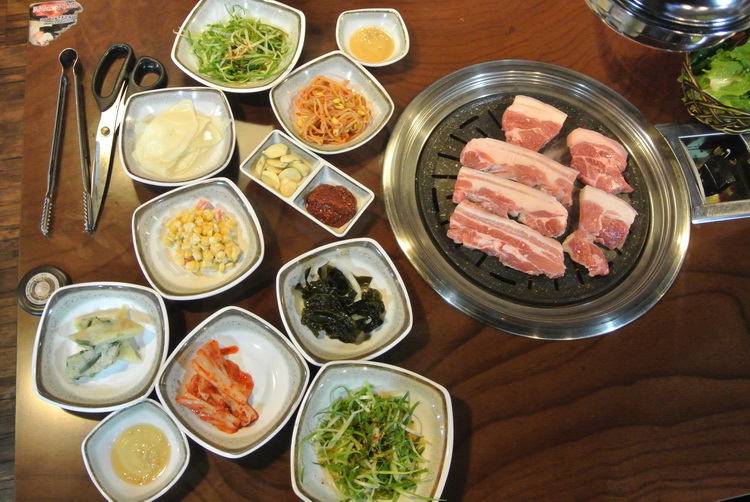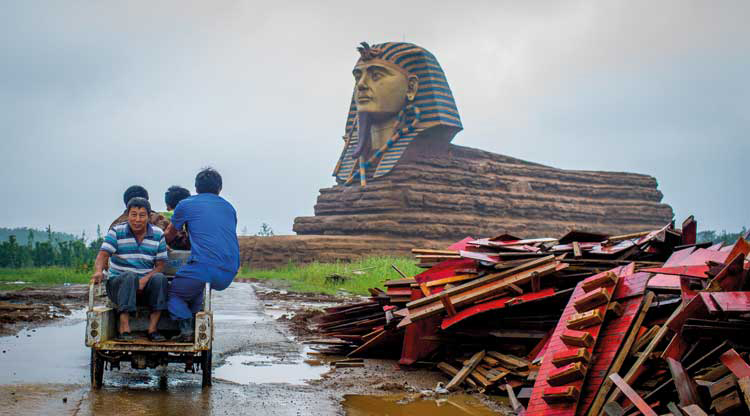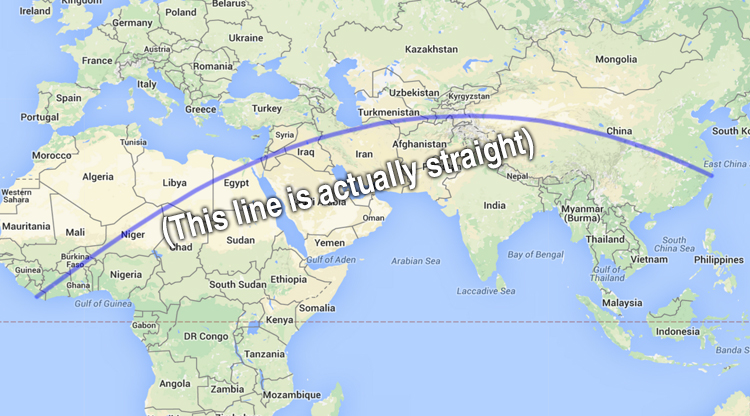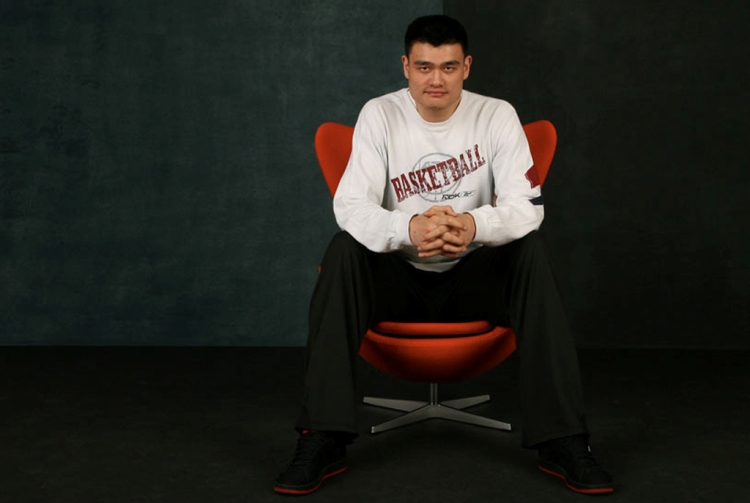By Erin Singleton
Think of Korean food, and the first things that’ll come to mind will probably be kimchi, bibimbap, BBQ and fried chicken. And don’t get us wrong, we’re all for them. But that’s not the only top-notch grub that can be found in South Korea.
A trip to Seoul and the honeymoon destination that is Jeju Island reveals plenty of other, equally enticing, culinary treats. Besides its beaches, natural geological features and volcanic landscape, Jeju Island, in the Korea Strait, is also known for its seafood and black pork. The Jeju Black Pig, or heuk-doe-ji, is a breed of domestic pig that is a popular item on the menus of most BBQ restaurants, as its thick skin and layers of fat make it especially well-suited for the Korean style of barbequing.
Crispy and flavorsome, the dish is the perfect star of a meal chock full of spicy pickled vegetables. Wash it down with soju, or Korean rice wine, and keep stuffing your belly full of meat.

Seafood, of course, is the other main ingredient of the island’s local cuisine. Walking around its urban areas, nearly every street is lined with restaurants sporting giant tanks right outside their front door. Each one overflows with flounder, abalone and octopus trying to escape their inevitable fate.
Jeon is one of the best ways to enjoy the daily catch. A pan-fried savory pancake stuffed with mussels, clams, cuttlefish and spring onions, it is greasy, salty and incredibly moreish, a guaranteed crowd-pleaser.
A hot stone pot with crab, abalone, clams and shrimp is also a delectable, lush affair of flavors of the sea, the seafood so fresh one can actually smell the breeze of the ocean while eating it.
.jpg)
Jeju seafood
If a carb-load is what you’re craving, any of the many chicken and beer restaurants dotting the island will get your fix just right. The blissfully sinful combo can be found at pretty much any street corner, with stalls, holes in the wall and more sizeable venues serving up hops and deep fried deliciousness tossed in a sticky, sweet and spicy sauce. A Korean institution, the chicken is crisp, juicy and, in some cases, so chili-drenched you’ll be at risk of hallucinating. It has been fried not just once, but at least twice, as a result of which it shows a thin, crackly and almost transparent skin. Never greasy, always delicious, it’s one of the messiest things you’ll ever eat - always served with a box of tissues and a bin for bones - so addictively good the finger-licking becomes almost an essential component of the meal.
Back to urban Seoul, things only get better. The food scene here is a lot more diverse, with many neighborhoods boasting their own distinct dishes or specialties. Picking just some of them is a truly hard feat. We recommend eating your way through as many as you can.
Myeongdong, Seoul’s incredible shopping district, the city’s countless markets and the artsy Insadong neighborhood are all good places to start. Here you can feast on spicy sausages and meatballs, French fries, hot dogs and mile-high cones of soft serve.
.jpg)
Erin browsing stalls on one of Myeongdong's food streets in Seoul.
The staples of Korean “fast food” are of course on offer too: gimbap (aka Korean sushi), bibimbap (hot stone pots full of rice, veggies and raw egg), omelets stuffed with fried rice, deep fried pork covered in a gravy and yukgaejang, a spicy soup made with shredded beef, eggs, scallions, and noodles.
A must-try is tteokbokki, glutinous tubular rice cakes usually swimming in in gochujang, a red chili pepper sauce. The so-called chips of Korea – ubiquitous and eaten standing up - they make the perfect snack on the go.
Particularly delicious is also the hoddeok, a yeasty pancake filled with a variety of fillings such as sugar, cinnamon and nuts and pressed on a hot oily griddle until flat and crunchy on the outside and perfectly gooey hot on the inside. It smells so good it takes a lot of willpower not to immediately take a huge bite, but be careful, because the inside is like molten lava for a solid five minutes.
Hongdae, the club district where you’ll find lots of young people and some more great food, is where you’ll want to go for some more barbecuing. Opt for one of the many hole-in-the-wall-type BBQ places, grab a few friends, order up some soju, throw some pork (samgyeopsal) or beef (sogogi) on the grill in the center of the table and dig in. The meat is fresh, the kimchi is spicy and the techno is blaring from neighboring dance halls. You wouldn’t want to be anywhere else.
When your liver recovers from the night out in Hongdae, give it a little bit more to suffer from by visiting a makgeolli house, which is basically the Korean version of a pub. A milky, fizzy rice wine once considered a farmer's drink, the liquor is currently undergoing a hipster revival, and many outlets around Seoul have started selling it. Admittedly quite pungent, the spirit comes also in flavors like apple or chestnut – try them all and order some pancakes to nibble on.

Seoul's Noryangjin Fish Market
No visit to Seoul, of course, would be complete without a dinner of raw seafood at Noryangjin Fish Market (above). A foodie’s paradise, the market boasts more than 700 stalls selling freshly caught fish, shellfish, squid and plenty of less-identifiable undersea treats. Sannakji, live octopus, should be on the list of things to try, although only for those with an adventurous palate: served fresh, the octopus’s sesame oil-coated tentacles are still wriggling around in between your chompers as you try to slurp them down without choking. If that doesn’t sound appealing, you can always buy some fresh sashimi from any vendor and have them slice it up right in front of you. If you prefer your seafood cooked, take your purchases to one of the restaurants around the edge of the market: they'll prepare your food and you can eat it at one of the tables provided.
One word of advice: in between a food stall and a visit to a local joint, make sure to buy a new pair of pants in one of the many markets. The pair you wore into Korea definitely won’t fit when you leave.
Burn Off Those Calories
JEJU ISLAND
Hike the Seongsan Ilchulbong
The Seongsan crater on the Southeast side of Jeju Island is a beautiful area for hiking. Once you arrive, it is about a thirty-minute walk up some stone stairs to its rim. On a clear day, you can stand on the rim and see the whole crater basin, which resembles a tropical rain forest.
 After hiking back down, walk down another few flights of stone stairs to the ocean, where you can see the famous haenyeo, or women divers, in action. This group of women have been free diving to collect abalone and octopus for generations, and many of them are still going strong at over 70 years old.
After hiking back down, walk down another few flights of stone stairs to the ocean, where you can see the famous haenyeo, or women divers, in action. This group of women have been free diving to collect abalone and octopus for generations, and many of them are still going strong at over 70 years old.
Walking Around Seogwipo
Seogwipo, the city on the southern side of Jeju Island, has several great areas for walking. One of them is the Seogwipo Artist Walk that starts at Lee Jung Seop Park and weaves through the city’s backstreets. There are also several waterfalls, including Jeongbang Falls, which flows right into the ocean. After visiting, you can walk along the harbor to a second waterfall, Cheonjiyeon Falls, nestled back in a beautiful park.
SEOUL
Walking through the Bukchon Village Seoul (from palace to palace)
One of the best walking trails in Seoul is between two of the famous palaces on the northern side of the city.

After exploring the Gyeongbokgung Palace in the morning walk east towards the Bukchon Village, an old settlement tucked away in the hills boasting some beautifully preserved old style roofs. There are alleys and hidden areas all through the neighborhood to explore and take pictures. Towards sunset, head further east still to the beautiful Changdeokgung Palace to round out the day.

Chnagdeokgung Palace, Seoul
Namsan Park
Namsan Park in the middle of downtown Seoul is one of the most iconic areas to hike in the city. On top of the hill is the Namsan Tower, which offers unparalleled views of the capital. You have the option to take a cable car up the hill, but if you want to make room for your next street food snack, we suggest hiking up.

If you’re not too worn out from the uphill hike, back on flat ground is another small cultural village called the Namsangol Hanok Village, a popular destination on a sunny day to spot people in traditional Korean dresses taking their wedding photos.
// Erin Singleton is a food blogger. Check more of her food writing at shanghaispice.wordpress.com





















0 User Comments